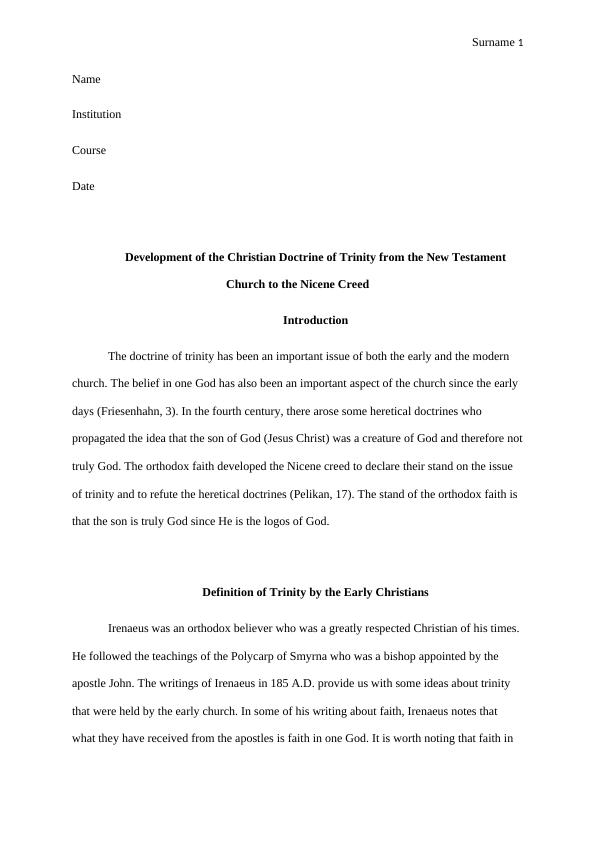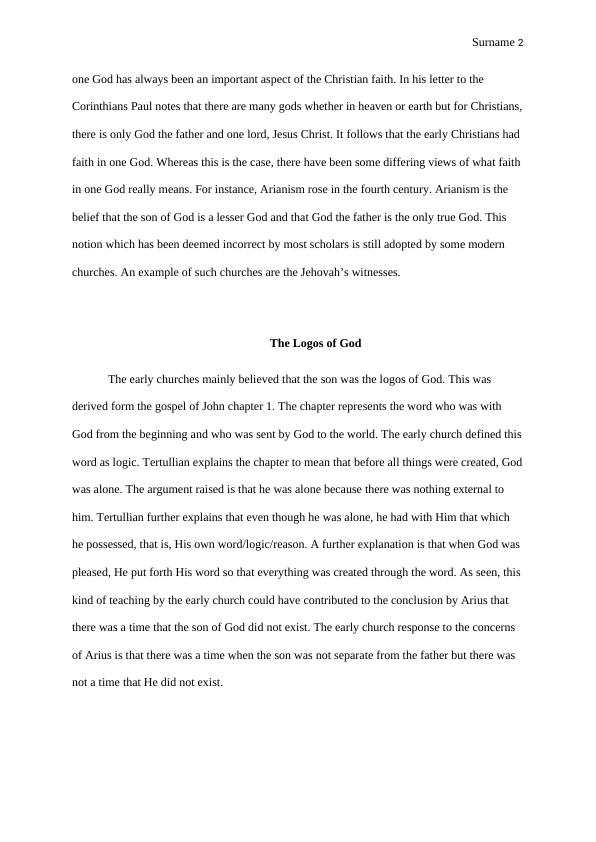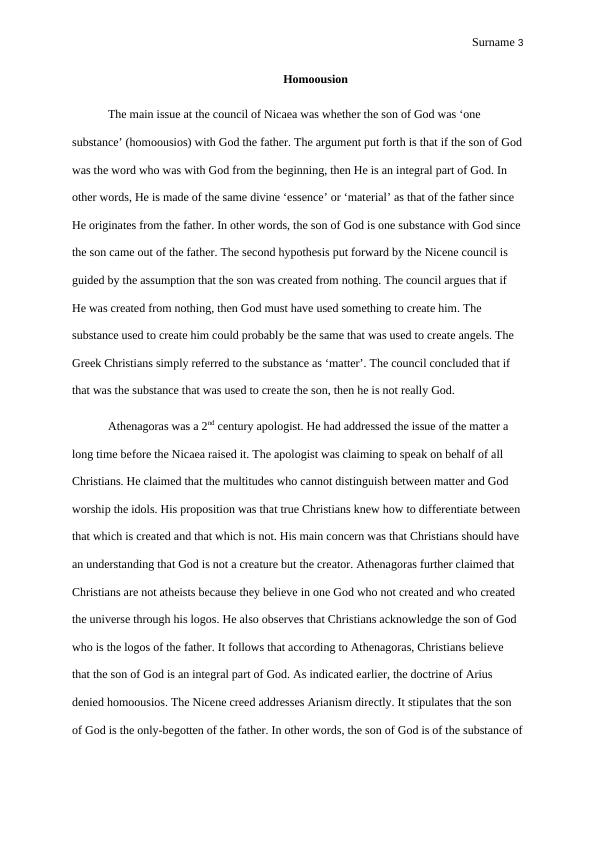Development of the Christian Doctrine of Trinity from the New Testament Church to the Nicene Creed
Added on 2023-06-03
6 Pages1844 Words374 Views
Surname 1
Name
Institution
Course
Date
Development of the Christian Doctrine of Trinity from the New Testament
Church to the Nicene Creed
Introduction
The doctrine of trinity has been an important issue of both the early and the modern
church. The belief in one God has also been an important aspect of the church since the early
days (Friesenhahn, 3). In the fourth century, there arose some heretical doctrines who
propagated the idea that the son of God (Jesus Christ) was a creature of God and therefore not
truly God. The orthodox faith developed the Nicene creed to declare their stand on the issue
of trinity and to refute the heretical doctrines (Pelikan, 17). The stand of the orthodox faith is
that the son is truly God since He is the logos of God.
Definition of Trinity by the Early Christians
Irenaeus was an orthodox believer who was a greatly respected Christian of his times.
He followed the teachings of the Polycarp of Smyrna who was a bishop appointed by the
apostle John. The writings of Irenaeus in 185 A.D. provide us with some ideas about trinity
that were held by the early church. In some of his writing about faith, Irenaeus notes that
what they have received from the apostles is faith in one God. It is worth noting that faith in
Name
Institution
Course
Date
Development of the Christian Doctrine of Trinity from the New Testament
Church to the Nicene Creed
Introduction
The doctrine of trinity has been an important issue of both the early and the modern
church. The belief in one God has also been an important aspect of the church since the early
days (Friesenhahn, 3). In the fourth century, there arose some heretical doctrines who
propagated the idea that the son of God (Jesus Christ) was a creature of God and therefore not
truly God. The orthodox faith developed the Nicene creed to declare their stand on the issue
of trinity and to refute the heretical doctrines (Pelikan, 17). The stand of the orthodox faith is
that the son is truly God since He is the logos of God.
Definition of Trinity by the Early Christians
Irenaeus was an orthodox believer who was a greatly respected Christian of his times.
He followed the teachings of the Polycarp of Smyrna who was a bishop appointed by the
apostle John. The writings of Irenaeus in 185 A.D. provide us with some ideas about trinity
that were held by the early church. In some of his writing about faith, Irenaeus notes that
what they have received from the apostles is faith in one God. It is worth noting that faith in

Surname 2
one God has always been an important aspect of the Christian faith. In his letter to the
Corinthians Paul notes that there are many gods whether in heaven or earth but for Christians,
there is only God the father and one lord, Jesus Christ. It follows that the early Christians had
faith in one God. Whereas this is the case, there have been some differing views of what faith
in one God really means. For instance, Arianism rose in the fourth century. Arianism is the
belief that the son of God is a lesser God and that God the father is the only true God. This
notion which has been deemed incorrect by most scholars is still adopted by some modern
churches. An example of such churches are the Jehovah’s witnesses.
The Logos of God
The early churches mainly believed that the son was the logos of God. This was
derived form the gospel of John chapter 1. The chapter represents the word who was with
God from the beginning and who was sent by God to the world. The early church defined this
word as logic. Tertullian explains the chapter to mean that before all things were created, God
was alone. The argument raised is that he was alone because there was nothing external to
him. Tertullian further explains that even though he was alone, he had with Him that which
he possessed, that is, His own word/logic/reason. A further explanation is that when God was
pleased, He put forth His word so that everything was created through the word. As seen, this
kind of teaching by the early church could have contributed to the conclusion by Arius that
there was a time that the son of God did not exist. The early church response to the concerns
of Arius is that there was a time when the son was not separate from the father but there was
not a time that He did not exist.
one God has always been an important aspect of the Christian faith. In his letter to the
Corinthians Paul notes that there are many gods whether in heaven or earth but for Christians,
there is only God the father and one lord, Jesus Christ. It follows that the early Christians had
faith in one God. Whereas this is the case, there have been some differing views of what faith
in one God really means. For instance, Arianism rose in the fourth century. Arianism is the
belief that the son of God is a lesser God and that God the father is the only true God. This
notion which has been deemed incorrect by most scholars is still adopted by some modern
churches. An example of such churches are the Jehovah’s witnesses.
The Logos of God
The early churches mainly believed that the son was the logos of God. This was
derived form the gospel of John chapter 1. The chapter represents the word who was with
God from the beginning and who was sent by God to the world. The early church defined this
word as logic. Tertullian explains the chapter to mean that before all things were created, God
was alone. The argument raised is that he was alone because there was nothing external to
him. Tertullian further explains that even though he was alone, he had with Him that which
he possessed, that is, His own word/logic/reason. A further explanation is that when God was
pleased, He put forth His word so that everything was created through the word. As seen, this
kind of teaching by the early church could have contributed to the conclusion by Arius that
there was a time that the son of God did not exist. The early church response to the concerns
of Arius is that there was a time when the son was not separate from the father but there was
not a time that He did not exist.

Surname 3
Homoousion
The main issue at the council of Nicaea was whether the son of God was ‘one
substance’ (homoousios) with God the father. The argument put forth is that if the son of God
was the word who was with God from the beginning, then He is an integral part of God. In
other words, He is made of the same divine ‘essence’ or ‘material’ as that of the father since
He originates from the father. In other words, the son of God is one substance with God since
the son came out of the father. The second hypothesis put forward by the Nicene council is
guided by the assumption that the son was created from nothing. The council argues that if
He was created from nothing, then God must have used something to create him. The
substance used to create him could probably be the same that was used to create angels. The
Greek Christians simply referred to the substance as ‘matter’. The council concluded that if
that was the substance that was used to create the son, then he is not really God.
Athenagoras was a 2nd century apologist. He had addressed the issue of the matter a
long time before the Nicaea raised it. The apologist was claiming to speak on behalf of all
Christians. He claimed that the multitudes who cannot distinguish between matter and God
worship the idols. His proposition was that true Christians knew how to differentiate between
that which is created and that which is not. His main concern was that Christians should have
an understanding that God is not a creature but the creator. Athenagoras further claimed that
Christians are not atheists because they believe in one God who not created and who created
the universe through his logos. He also observes that Christians acknowledge the son of God
who is the logos of the father. It follows that according to Athenagoras, Christians believe
that the son of God is an integral part of God. As indicated earlier, the doctrine of Arius
denied homoousios. The Nicene creed addresses Arianism directly. It stipulates that the son
of God is the only-begotten of the father. In other words, the son of God is of the substance of
Homoousion
The main issue at the council of Nicaea was whether the son of God was ‘one
substance’ (homoousios) with God the father. The argument put forth is that if the son of God
was the word who was with God from the beginning, then He is an integral part of God. In
other words, He is made of the same divine ‘essence’ or ‘material’ as that of the father since
He originates from the father. In other words, the son of God is one substance with God since
the son came out of the father. The second hypothesis put forward by the Nicene council is
guided by the assumption that the son was created from nothing. The council argues that if
He was created from nothing, then God must have used something to create him. The
substance used to create him could probably be the same that was used to create angels. The
Greek Christians simply referred to the substance as ‘matter’. The council concluded that if
that was the substance that was used to create the son, then he is not really God.
Athenagoras was a 2nd century apologist. He had addressed the issue of the matter a
long time before the Nicaea raised it. The apologist was claiming to speak on behalf of all
Christians. He claimed that the multitudes who cannot distinguish between matter and God
worship the idols. His proposition was that true Christians knew how to differentiate between
that which is created and that which is not. His main concern was that Christians should have
an understanding that God is not a creature but the creator. Athenagoras further claimed that
Christians are not atheists because they believe in one God who not created and who created
the universe through his logos. He also observes that Christians acknowledge the son of God
who is the logos of the father. It follows that according to Athenagoras, Christians believe
that the son of God is an integral part of God. As indicated earlier, the doctrine of Arius
denied homoousios. The Nicene creed addresses Arianism directly. It stipulates that the son
of God is the only-begotten of the father. In other words, the son of God is of the substance of

End of preview
Want to access all the pages? Upload your documents or become a member.
Related Documents
THEOLOGY AND RELIGIOUS STUDIES.lg...
|13
|747
|35
Christological Focus the Study of Christian Divinitylg...
|11
|2766
|358
The Concept of Trinity in Christian Theologylg...
|6
|1234
|245
The Mind of the Maker: Book Report and Analysislg...
|5
|846
|397
The Essence of Christianity - PDFlg...
|7
|1207
|155
Ministerial Theology Assignment 2022lg...
|10
|2833
|17
